
Govt Must Shut Down Alt News

Trust the government? Not in a Pink Fit!
https://www.tomgrimshaw.com/tomsblog/?p=31429
A Wake Up Call From A Teacher

FDA: Vaccines Don’t Have to Prevent Infection or Transmission
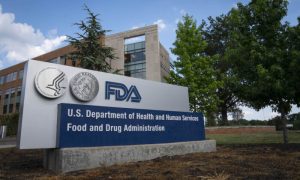
Vaccines don’t have to prevent infection or transmission to be cleared in the United States, the country’s top regulatory agency said in a new document.
“It is important to note that FDA’s authorization and licensure standards for vaccines do not require demonstration of the prevention of infection or transmission,” Dr. Peter Marks, a top official at the U.S. Food and Drug Administration (FDA), said in the document.
Marks was writing as he rejected nearly all recommendations from a group of experts that advised the FDA to update the labels for the Pfizer and Moderna COVID-19 vaccines.
Vaccines are traditionally known as drugs that prevent an illness. The U.S. Centers for Disease Control and Prevention (CDC) for years said a vaccine is a product that “produces immunity” while vaccination is an injection of an infectious organism “in order to prevent the disease.” The agency changed its definitions after people correctly noted that COVID-19 vaccines do not prevent infection.
The Coalition Advocating for Adequately Labeled Medicines, a group of experts, had called for the FDA to make clear that the COVID-19 vaccines don’t prevent infection or transmission.
“There is a widespread (but inaccurate) notion that efficacy against infection and transmission have been established by substantial evidence, and that these vaccines contribute to herd immunity,” the group said, pointing to claims from President Joe Biden, the head of the CDC, and Dr. Anthony Fauci that vaccinated people would not get sick or infected.
Biden, for instance, falsely said in 2021 that “you’re not going to get COVID if you have these vaccinations.”
“To remedy this situation, language clarifying that phase III trials were not designed to determine and failed to provide substantial evidence of vaccine efficacy against SARS-CoV-2 transmission or death must be added to labels,” the coalition said. SARS-CoV-2 causes COVID-19.
While it’s uncommon to include in product labeling what a product has not been proven to do, there are cases where it’s necessary due to inaccurate assumptions, the coalition said. They pointed to the FDA stating that the influenza medicine Tamiflu “has not been shown to previous serious complications of influenza” after the drug’s manufacturer said it reduced complications by nearly half.
Marks rejected the request, writing that the petitioners included “selected statements by U.S government officials suggesting that vaccination against COVID-19 may prevent infection or transmission” but omitted statements from Fauci and others that later acknowledged vaccines don’t prevent infection or transmission.
“In responding to your Petition, we are not agreeing or disagreeing with any of the statements that are selected in the Petition,” Marks said. “Rather, we are observing that the statements referenced by the Petition do not demonstrate a commonly held belief that the clinical trials provided substantial evidence of efficacy against SARS-CoV-2 transmission. We are not convinced that there is any widespread misconception about this.”
The head of the CDC, Dr. Rochelle Walensky, is among those maintaining to the present day that the vaccines at one point completely prevented transmission and symptomatic illness.
Trial data showed high efficacy against symptomatic illness but not 100 percent efficacy. Real-world data has shown lower effectiveness. The trials were not designed to measure transmission, the FDA has said in various documents.
Authorization Standards
Marks also said that the FDA can authorize or approve a vaccine even if there’s no “demonstration of the prevention of infection of transmission.”
“A vaccine can meet the licensure standard if the vaccine’s benefits of protecting against disease outweigh the vaccine’s risks for the licensed use,” he added. “There is no requirement that the vaccine also prevents infection with the pathogen that can cause the disease or transmission of that pathogen to others.”
Emergency use authorization (EUA) can be granted “without any evidence that the vaccine prevents infection or transmission,” he also said.
EUAs were given to the Pfizer and Moderna COVID-19 vaccines in late 2020 due to a March 2020 declaration by then-Health Secretary Alex Azar under the Public Readiness and Emergency Preparedness (PREP Act) Act. The vaccines were later approved, though the FDA reverted to emergency authorization this month when it switched all existing COVID-19 vaccines from the companies to the updated, unproven bivalent formulations.
Linda Wastila, a professor in the Department of Practice, Sciences, and Health Outcomes Research at the University of Maryland School of Pharmacy, said she was surprised by Marks’ assertion.
“I am totally flabbergasted that the FDA responded that proof of prevention of infection and transmission is not necessary for an EUA vaccine,” Wastila, who is part of the coalition, told The Epoch Times via email. The comment “makes me wonder if the FDA has ANY standards of safety and efficacy of the EUA vaccines,” she added.
Under the PREP Act, an emergency authorization can be given for a product used to diagnose, treat, or prevent a disease or condition when officials conclude that the product “may be effective” in diagnosing, treating, or preventing the disease or condition and “the known and potential benefits of the product, when used to diagnose, prevent, or treat such disease or condition, outweigh the known and potential risks of the product.”
That assessment is based on “the totality of scientific evidence available … including data from adequate and well-controlled clinical trials.”
No clinical trial efficacy data has been made public for the bivalent vaccines.
The FDA did not respond to a request for comment. Marks noted that the FDA cleared the vaccines “for active immunization to prevent coronavirus disease 2019 (COVID-19) caused by SARS-CoV-2.”
“The vaccines are not licensed or authorized for prevention of infection with the SARS-CoV-2 virus or for prevention of transmission of the virus, nor were the clinical trials supporting the approvals and authorizations designed to assess whether the vaccines prevent infection or transmission of the virus,” he said.
Lack of Safety Data
Other proposed changes that were rejected, included making clear that the FDA authorized a new Pfizer vaccine formulation with a different buffer without requiring studies to evaluate the efficacy or safety.
Kim Witczak, founder of Woodymatters and another member of the coalition, criticized the response letter.
“Honest communication and transparency is key to trusting our regulatory agencies. However, the FDA’s response to the citizen petition shows they are not really interested in transparency and sharing more information with the public,” she told The Epoch Times in an email. “With an experimental rushed product, safety is paramount and the public deserves the good, the bad and ugly in real time.”
The FDA only accepted a single proposal. It added some data from a trial to the labeling for the new Pfizer bivalent vaccine.
Before this month, the labels did not include any data from trials, because the FDA authorized the new vaccines as boosters without any trial data.
After the fall 2022 authorizations, Pfizer and Moderna announced that trials showed the bivalent triggered higher levels of neutralizing antibodies than the old vaccines. Antibodies are thought to protect against COVID-19. Pfizer said the data showed a favorable “safety profile” while Moderna said that “no new safety concerns were identified.” The coalition said the labeling “should be updated to reflect current data.”
While granting authorization for the bivalents as regular shots, the FDA updated the health care provider and recipient fact sheets for Pfizer’s bivalent to include the safety data Pfizer announced. But it did not include any immunogenicity data or any data on Moderna’s vaccine.
“FDA has not conducted an evaluation of the data that is referenced in the press release,” Marks said.
Many Insomniacs Remain Conscious During Sleep
- Up to 70 million Americans have a sleep disorder, the most common of which is insomnia; 10% of American adults struggle with chronic insomnia and 30% report occasional or short-term insomnia
- Research finds you can remain consciously aware even while your brain and body are sleeping
- Insomniacs who report being awake even when their brain wave patterns indicate they’re sleeping have increased activity in brain areas associated with conscious awareness during the dreamless phase of sleep
- If you struggle with insomnia and frequently feel you’ve not slept a wink, processes involved in reducing your conscious awareness during sleep may be impaired. Practicing mindfulness is thought to target these processes and may help improve your sleep experience
- Sleeping pills are very limited in their effectiveness and have serious side effects. Safe and natural sleep aids include melatonin, 5-HTP, valerian, chamomile tea
Originally published April 19, 2018.
According to the American Sleep Association,1 up to 70 million Americans have a sleep disorder, nearly 40% unintentionally fall asleep during the day at least once a month and nearly 5% have nodded off while driving at least once. Insomnia is the most common sleep disorder, with 10% of American adults struggling with chronic insomnia and 30% reporting occasional or short-term insomnia.
Interestingly, insomniacs will often insist they’ve not slept a wink all night, even though they’ve actually been sleeping. Researchers have now discovered there’s a reason for this discrepancy in experience, and it has to do with consciousness. In a nutshell, even though the brain is sleeping, insomniacs remain consciously aware, and therefore believe they’ve not slept at all.
Many Insomniacs Remain Conscious Even When Asleep
Daniel Kay, a psychology professor at Brigham Young University in Utah who led the study,2 told Medical News Today,3 “… [Y]ou can be consciously aware and your brain [can] be in a sleep pattern. The question is: What role does conscious awareness have in our definition of sleep?” Traditionally, it’s been believed that sleeping involves the absence of conscious awareness, but Kay’s team was able to conclude that this is not categorically true.
To investigate the role of consciousness during sleep, the team analyzed the sleep patterns and subjective experience of 32 people with insomnia and 30 who reported sleeping well.
Once the participants were deemed to be asleep, based on their brain patterns, a radioactive tracer was injected into their arms. Using brain imaging, the researchers were able to examine neurons that remained active during sleep, and their exact locations. The following morning, the participants were asked about their subjective experience of their sleep. Medical News Today explains the results:
“The study found that people with insomnia who reported that they had been awake, even when the polysomnography showed otherwise, had increased activity in brain areas associated with conscious awareness during the dreamless phase of sleep — that is, nonrapid eye movement sleep …
[I]t is normal during the process of falling asleep for the brain to send inhibitory neurons that make people less and less consciously aware until they’ve reached a state of deep sleep. However, what the findings of the new study suggest is that people with insomnia may not feel as though they’re asleep until their brain experiences a greater inhibitory activity in areas that are linked to conscious awareness.”
Normal Sleepers May Not Get as Much Sleep as They Think
As noted by the authors,4 “Brain activity in the right anterior insula, left anterior cingulate cortex, and middle/posterior cingulate cortex may be involved in the perception” of insomnia. People who reported sleeping well turned out to have increased activity in the same areas of the brain as insomniacs. The reason for this is because your brain goes through “an inhibition process” when you fall asleep, gradually lowering your conscious awareness.
While insomniacs require a greater level of inhibition before their consciousness recedes, many good sleepers report falling asleep long before their brainwaves indicate that they’re actually sleeping. This is basically the reverse situation of insomnia: Good sleepers lose conscious awareness at a very low level of inhibition, making them believe they fell asleep much faster than they actually did, based on their brain patterns.
Mindfulness Recommended for Insomniacs
So, if you struggle with insomnia, frequently feeling you haven’t slept a wink, what can you do? Kay says, “In patients with insomnia, processes involved in reducing conscious awareness during sleep may be impaired. One of the strategies for targeting these processes may be mindfulness. It may help the patients inhibit cognitive processes that are preventing them from experiencing sleep.”
Practicing “mindfulness” means you’re actively paying attention to the moment you’re in right now. Rather than letting your mind wander, when you’re mindful, you’re living in the moment and letting distracting thoughts pass through your mind without getting caught up in their emotional implications.
You can add mindfulness to virtually any aspect of your day — even while you’re eating, working or doing household chores like washing dishes — simply by paying attention to the sensations you are experiencing in the present moment.
The idea is to reach a place of “restful” or “concentrated” alertness, which enables you to let negative thoughts and distractions pass by you without upsetting your calm and balance.
For instance, focusing your mind on your breath is one of the most basic, and most rewarding, relaxation and meditation/mindfulness strategies there is.
Common Factors That Keep You Awake
Aside from the possibility that you’re simply misperceiving your inability to sleep, certain environmental factors can make it more difficult to fall asleep. This includes such things as:5
- Your pillow being too hot — A cool pillow, and more importantly the room temperature overall, will decrease your core body temperature, which induces drowsiness. In one study, insomniacs equipped with a cooling cap fell asleep within 13 minutes — three minutes faster than normal sleepers — and remained asleep 89% of the night. Reader’s Digest6 suggests placing your pillow in the freezer for a few minutes before bed to cool it down.
- Starting a new medication — A number of different drugs can cause insomnia, including blood pressure medications, antidepressants and steroids. Oftentimes, this side effect can be ameliorated by changing the time at which you take the drug. Beta-blockers, prescribed for high blood pressure and/or arrhythmia, for example, are typically best taken in the morning instead of at night.
- Pets — As much as you love your fur babies, if they’re hogging your bed or filling it with hair, consider keeping your pets out of your bed. According to one Mayo Clinic study,7 while some find their pets help them sleep better, approximately 20% of pet owners admitted the animal disrupted their sleep in one way or another.
- Cold feet — While cooling your head induces sleep, cold feet can keep you tossing and turning. The solution: Wear socks to bed.
- Exhaustion — While exhaustion is frequently confused with tiredness, the two are not the same. When exhausted from stress or overwork, your brain tends to be on high alert. This “cognitive popcorn” can make it difficult to fall asleep, no matter how exhausted your body is. Rather than falling into bed right away after a long day, try winding down, allowing your mind to settle before trying to fall asleep.
When Anxiety or an Overactive Mind Keeps You Awake
Researchers at the American Academy of Sleep Medicine discovered that how you cope with stress might have an even greater impact on your sleep than the number of stressors you encounter.
They also found that mindfulness therapies worked best for suppressing the “mental chatter” that inhibits the onset of sleep. Lead author Vivek Pillai, Ph.D., wrote,9 “While a stressful event can lead to a bad night of sleep, it’s what you do in response to stress that can be the difference between a few bad nights and chronic insomnia.”
Avoid Sleeping Pills for Insomnia
To learn more about the ins and outs of sleep, and lots more tips and strategies to improve your quality and quantity of your rest, please see “Sleep — Why You Need It and 50 Ways to Improve It.” Whatever you do, avoid sleeping pills. Not only do they have extremely limited benefits, the side effects can be quite severe. Take Belsomra, for example, a next-gen type sleeping pill that acts on a neurotransmitter called orexin “to turn down the brain’s ‘wake messages.'”
The company’s own clinical trials showed the drug allowed people to fall asleep an average of six minutes sooner than those taking a placebo, and stay asleep 16 minutes longer.
More than 1,000 consumer complaints against Belsomra have been filed with the U.S. Food and Drug Administration, with complaints ranging from lack of effectiveness and next-day drowsiness to sleep paralysis, heart problems and suicidal ideation. One in 5 reports claim the drug made them the opposite of sleepy.10
Other research has found sleeping pills like Ambien, Lunesta and Sonata reduce the average time it takes to fall asleep by about 13 minutes compared to placebo, while increasing total sleep time by about 11 minutes.11 Interestingly, participants believed they had slept longer, by up to one hour, when taking the pills. This is thought to be due to anterograde amnesia, which causes trouble with forming memories.
When people wake up after taking sleeping pills, they may, in fact, simply forget they’d been unable to sleep. Sonata is also associated with addiction.12 Studies have also shown that use of sleeping pills increase your risk of death and cancer.13 To learn more about the hazards of sleeping pills, see Dr. Daniel Kripke’s e-book, “The Dark Side of Sleeping Pills.”14
Natural Sleep Remedies
Fortunately, there are far safer options. While you work on addressing the root causes of your sleep problems, temporarily using a natural sleep aid may help you get to sleep easier. Following are a handful of alternatives:
•Melatonin — In scientific studies, melatonin has been shown to increase sleepiness, help you fall asleep more quickly and stay asleep, decrease restlessness, and reverse daytime fatigue. Melatonin is a completely natural substance, made by your body, and has many health benefits in addition to sleep. Start with as little as 0.25 milligrams (mg) and work your way up in 0.25 mg increments until you get the desired effect.
•5-hydroxytryptophan (5-HTP) — One of my favorite sleep aids is 5-HTP. 5-HTP is the hydroxylated form of tryptophan. It easily passes your blood brain barrier when it is converted to serotonin (thereby giving mood a boost) and then to melatonin (enhancing sleep).
I believe this is a superior approach to using melatonin. In one study, an amino acid preparation containing both GABA (a calming neurotransmitter) and 5-HTP reduced time to fall asleep, increased the duration of sleep and improved sleep quality.15
•Valerian root — Studies have found valerian root helps improve the speed at which you fall asleep, depth of sleep (achieving deep sleep 36% faster16) and overall quality of sleep. Start with a minimal dose and use the lowest dose needed to achieve the desired effect, as higher dosages can have an energizing effect in some people. Typical dosages used in studies range between 400 mg and 900 mg, taken anywhere from 30 minutes to two hours before bed.
•Chamomile tea — This herb is typically used in the form of infusions, teas, liquid extracts or essential oils made from the plant’s fresh or dried flower heads. It has sedative effects that may help with sleep, which is why chamomile tea is often sipped before bed.
Extracts from: https://articles.mercola.com/sites/articles/archive/2023/04/26/insomniacs-remain-conscious-during-sleep.aspx
Tucker Carlson Leaves Fox News

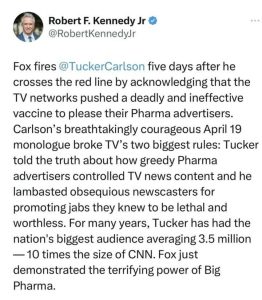
Tucker defined good and evil:
“Good is characterized by order, calmness — tranquility, peace, whatever you want to call it — lack of conflict, cleanliness. Cleanliness IS next to Godliness. It’s true, it is. And Evil is characterized by their opposite. Violence, hate, disorder, division, disorganization, and filth. So, if you are all in on the things that produce the latter basket of outcomes, what you’re really advocating for is Evil. It’s true… I’m not making a partisan point, at all. I’m just noting what’s super-obvious.”
LIVE: Tucker Carlson Keynote Address | Heritage 50th Anniversary Celebration
Lumbrokinase and Nattokinase
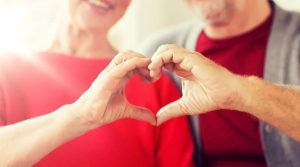
A one-year controlled clinical trial of lumbrokinase supplementation in 192 patients showed a reduction in arterial plaque and a 4.7% reduction in the risk of stroke with no significant adverse effects.
https://allergyresearchgroup.blog/enzymes-from-the-earth-lumbrokinase-nattokinase-and-heart-health/
Good For Days
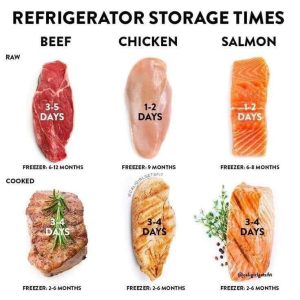
Buyer Beware! Again.

If you have to study every single label to work out whether supermarket food is actually safe to eat is it REALLY worth it?
Here is another little example of the dangers lurking on supermarket shelves and on the small print on their labels.
These “Extra Special” and “Unwaxed lemons” seem at first glance to be healthy and very good for you. We all know about the health power of lemons right? They describe it as “Perfect for zesting” and that’s why it’s unwaxed as who would want to zest a waxed lemon?
But Zoom in and you see that the label displays in very small print “treated with Imazalil, Fludioxonil and Pyrimethanil”. It doesn’t tell you anywhere on the written copy about this warning just in tiny writing on the photo of the label.
So what are Imazalil, Fludioxonil and Pyrimethanil? They are chemical fungicides basically to prevent mould and add to shelf life. A quick search on the web reveals this
Imazalil
The side effects listed in our database mainly concern respiratory problems and muscular coordination although it is a suspected carcinogen and a probable endocrine disrupter.
Fludioxonil
List of known side effects · Liver necrosis, centrilobular hypertrophy, increased serum cholesterol and 5 ‘nucleotidase. Nephropathy, (Nephropathy is the deterioration of kidney function. The final stage of nephropathy is called kidney failure, end-stage renal disease, or ESRD. According to the CDC, diabetes is the most common cause of ESRD.)
Pyrimethanil
Pyrimethanil produces thyroid follicular cell tumors in rats and enhancement of hepatic thyroid hormone metabolism.
So I have to ask the question. Does it really sound “perfect for zesting” to you?
You would think zesting the rind and peel of something with these ingredients on it would be the last thing a supermarket would promote to its customers right?
#ditchthesupermarkets you owe them NOTHING!
Maybe it’s time to look for healthier food sourcing options to limit your toxin intake.
In the UK there is http://www.goodfoodproject.co.uk
Natural Painkillers
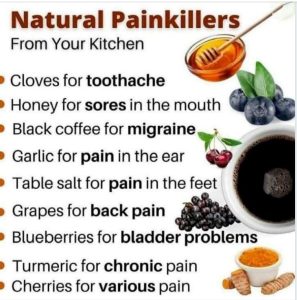
Saw this and wanted to ask you, love to hear from you if you have experienced relief with any of these.
